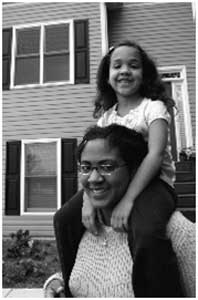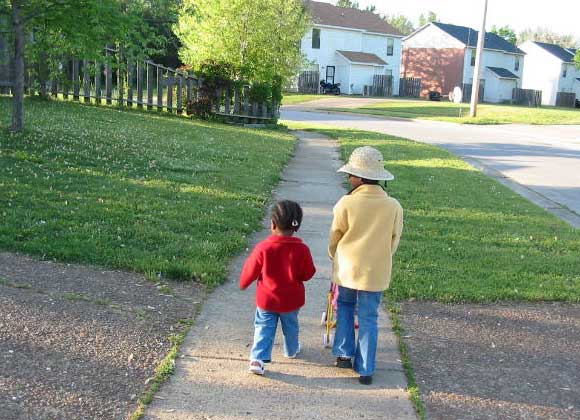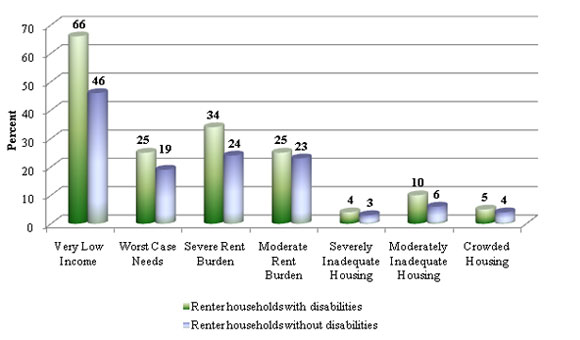|

Researchers and practitioners recently gathered to share HOPE VI experiences and to examine how lessons learned can be applied to future housing policy.
In mid-March 2011, HUD’s Office of Policy Development and Research and the Council of Large Public Housing Authorities gathered housing researchers and practitioners to review lessons learned thus far from HOPE VI projects. As PD&R Assistant Secretary Raphael Bostic said, it was a time for “lifting up” the lessons of the HOPE VI program, celebrating its successes, and moving forward to apply this knowledge to the next generation of housing policy. The forum reviewed research that evaluated early HOPE VI experiences and studies pertaining to living in mixed-income developments, spillover economic effects, and life transformation outcomes of HOPE VI.
Early Experiences. Larry Buron of Abt Associates laid the groundwork for the ensuing discussion with an overview of the HOPE VI Cross-Site Study. This interim evaluation explored the effects of HOPE VI on residents, developments, and neighborhoods shortly after rehabilitated or rebuilt public housing sites are reoccupied. Of 15 early HOPE VI sites that were part of a baseline assessment in 1996, 11 were substantially inhabited by 2002, permitting a comparison of resident groups before and after HOPE VI.
Living in Mixed-Income Developments. Mark Joseph of Case Western Reserve University discussed current research in Chicago that studies residents’ experiences living in mixed-income developments and investigates strategies used to support community building in these new developments. The physical revitalization of housing units and neighborhoods is just the beginning, said Joseph. “Building community and changing life trajectories will require sustained, comprehensive, and strategic effort. Although mixed-income development holds significant promise as a poverty deconcentration strategy, its implementation is deeply complicated.”
The benefits to residents of mixed-income development are not clear-cut, although this research finds residents are highly satisfied with their physical environment. There is a concomitant reduction in stress when concerns over safety and social disorder have been ameliorated, as well as some articulation by relocated public housing residents of increased aspirations. On the other hand, they also report increased stress from expectations (rules, monitoring, norms), less social interaction, financial responsibilities, and feeling stigmatized. Renters and owners of both affordable and market-rate units find satisfaction in the location, design, and market value of their housing. However, the challenges of living comfortably with neighbors of differing socioeconomic backgrounds, perhaps with limited meaningful social interaction, are also real. The research team noted that perceptions of difference are being reinforced in "interactions and conversations within and across groups of residents in ways that may be hard to undo."1
Economic Spillover. Michael Mariano of Econsult Corporation described a cost-benefit analysis conducted in six localities to determine the extent of HOPE VI development spillover economic effects on surrounding neighborhoods, economic activity in the region, and changes in tax revenues. This study found significant widespread gains in property values, notable declines in violent crime, and increased value of implied rental subsidies. Redevelopment, higher household incomes, and increased consumer spending stimulated regional economic activity, which in turn increased local government tax revenues from property, income, and sales. These spillover effects are not independent of local market conditions; they rely on the presence of other economic activity and commitments made by the public and private sectors. As Mariano emphasized, "HOPE VI itself is unlikely to spark significant neighborhood change single-handedly."

Residents of HOPE VI redevelopments seem satisfied with their new homes and confirm positive changes in their neighborhood, such as a decrease in crime.
Life Transformation. Diane Levy of the Urban Institute summarized findings from the HOPE VI Panel Studies that have tracked living conditions and well-being of residents from HOPE VI sites since 2001. Most residents are heads of households who are single African-American females. Three out of four have children, and 42 percent have children under 6 years old. Their incomes, employment rates, and education levels are extremely low. About 10 percent of residents are at least 62 years old.
Forty-three percent of these households received vouchers that allowed them to move to privately owned housing of their choice. These households benefited from improvements in housing and neighborhood quality, neighborhood safety, and mental health.
Although HOPE VI did not seem to create positive changes in employment, a strong relationship between working and health problems became apparent during the study. Levy reported that poor health is a big challenge to the well-being of HOPE VI participants. Only 59 percent of participants reported being in excellent or good health. African-American women suffered from arthritis, asthma, obesity, depression, diabetes, hypertension, and stroke more frequently than the national average, and mortality rates were quite high. In 2009, in an additional survey of the Chicago families included in the Panel Study, residents reported that their physical health continued to deteriorate. Rates of chronic conditions and disability had increased, and the mortality rate of Chicago HOPE VI residents remained extremely high at 14 percent.2
Although this research suggests that HOPE VI has improved living environments for both private market and mixed-income residents, gains for those remaining in traditional public housing are largely unrealized. By concluding that “hard to house” families require a different approach than HOPE VI to facilitate transformation, a Chicago Family Case Management Demonstration study significantly enhanced case management and supportive services. The three-year demonstration ending in 2010 was successful in improving housing, neighborhood, employment, and health outcomes for families. Advances did not occur in outcomes for children and youth, however, and mortality rates continued to be very high.
Looking Ahead
These presentations of HOPE VI research generated a lively exchange among practitioners and researchers, and several considerations for shaping next-generation housing policy emerged from the discussion. An immediate concern was the effect of the recession on existing HOPE VI developments. It was noted that mixed-income developments are suffering in this economy and that foreclosures among market-rate units are causing instability. The need for greater clarity in terminology was raised, including questions such as, “What really constitutes success?” and “How should choice be defined?” Requirements for more data and more research, especially large, longitudinal studies, were articulated throughout the discussion. Practitioners emphasized that comprehensive use of partnerships and integration with all segments of the community (including jobs, schools, and financial institutions) are important in bringing about changes in housing policy that will deconcentrate poverty and transform the lives of low-income and hard to house families.
1 The University of Chicago School of Social Service Administration and Case Western Reserve University’s Mandel School of Applied Social Sciences, Mixed-Income Development Study, Research Briefs 1–3, 2009.
2 The 2009 national mortality rate was 0.741 percent, according to the Centers for Disease Control and Prevention.
BACK TO THE TOP

FSS participants enter into a contract with their public housing authority to achieve economic independence.
The Family Self-Sufficiency Program (FSS), established in 1990 by the Cranston-Gonzalez National Affordable Housing Act, allows low-income families who receive housing vouchers to build the assets necessary to achieve economic self-sufficiency. Families who enroll in the voluntary program sign a five-year contract of participation with their public housing authority (PHA) establishing a plan for attaining economic independence.
FSS participants meet with case managers who provide training in financial literacy and referrals to supportive services, such as childcare and education programs. Each participant also receives an escrow account managed by the PHA. Normally, rent increases as the family’s income rises. In the FSS program, credits based on increased income are deposited into the escrow account. When participants graduate from FSS, they receive the total amount banked plus interest. Although they may use their savings however they wish, they are advised to put their money toward asset-building activities such as reducing debt, buying a home, investing in education, or starting a business. Participants who do not complete FSS forfeit their escrow.
In a recent study of 181 FSS participants, researchers in HUD’s Office of Policy Development & Research assessed FSS participants’ outcomes from 2005 to 2009. Among other criteria, each of the programs analyzed included up to 20 families who had enrolled in FSS between July 2005 and March 2006.
Study Design and Outcomes
For the study — the second of a three-part evaluation of FSS — researchers obtained data from case managers; conducted phone interviews with FSS coordinators and participants; and, to get a sense of the programs in action, made site visits to programs in Orange and Riverside Counties, California; Montgomery County, Maryland; and Missoula County, Montana.
After four years of study, the researchers found that:
-
24 percent graduated from the program and received their escrow funds; 4 families had purchased homes.
-
37 percent left the program without graduating, forfeiting their escrow accounts.
-
39 percent were still enrolled; according to caseworkers and predictors of graduation rates, 43 of these families were on track to graduate.
The study also showed that FSS enabled participants to achieve meaningful savings in a relatively short period, with graduates averaging $5,300 in escrow by the time they completed FSS. Likewise, those participants still enrolled in the program when the study ended showed significant gains; by 2009, their escrow balances averaged $3,500. Participants who left the program and forfeited their escrow accounts had savings that averaged $2,140 when they dropped out.
FSS graduates also made significant strides in income. Average income among graduates increased from $19,902 their first year in FSS to $33,390 the year they graduated. By contrast, those who left the program showed very modest gains in annual income, from $15,551 their first year to $15,918 the year they left the program. Participants still enrolled in 2009 increased their income by an average of 11 percent.
Differences Between Graduates and Other Participants
Researchers also looked at the different characteristics among graduates and other participants. They found the following:
-
93 percent of program graduates were mostly employed throughout the study, compared with only 60 percent of those who left the program.
-
FSS graduates began the program with higher incomes and with higher rates of employment than those who left the program.
-
Participants still enrolled in FSS when the study ended had larger households than graduates or people who left the program.
-
People who drop out of the program are likely to do so after two years or less.
Researchers hope that by considering such analyses, caseworkers may be able to help more people to stay enrolled in — and benefit from — FSS.
BACK TO THE TOP
HUD’s tenant-based rental assistance program, also known as the Housing Choice Voucher program, served 2.1 million households in fiscal year 2009. The program allows low-income families to choose their housing unit from the stock of affordable privately owned rentals. Although studies show that these families are satisfied with their housing units, little research exists on whether they are happy with their neighborhoods. A recent paper presented by Lauren Ross at the 2011 American Housing Survey (AHS) User Conference explores the neighborhood perceptions of both assisted and unassisted renters, the effects of the housing search process on the neighborhood satisfaction of renters who recently moved, and whether housing assistance — independent of other household and neighborhood characteristics — affects neighborhood satisfaction.

Voucher assistance offers greater choice in housing to low-income families that may lead to greater satisfaction with their homes but not necessarily with their neighborhoods.
Using 2009 AHS data on the characteristics of individual renters, their households, and their neighborhoods, Ross found that voucher households were more likely than unassisted households to have unmarried African-American females as the head of household, live in central cities, receive welfare assistance, and include a disabled family member or children. Voucher households had a median income that was $28,000 lower than that of unassisted households, placing them below the poverty line.
On household assessments of neighborhood and housing quality, both assisted and unassisted households appeared to be equally satisfied with their housing, although households with vouchers reported more serious crime and fewer available community services than did unassisted renters. Voucher holders were less satisfied with their neighborhoods than with their homes. By contrast, when controlling for other household and neighborhood characteristics, voucher holders were more satisfied with their housing than with their neighborhoods when compared with unassisted renters. Recent mover data show that voucher holders were more likely than unassisted households to look at other neighborhoods before choosing their current unit, but the search did not affect their neighborhood satisfaction.
The intent of voucher assistance is to offer greater choice in housing to low-income households. This choice does not necessarily override the constraints of inadequate, affordable housing, racial and locational factors, perceptions of community services and crime, and concentrated social problems and disadvantages that burden households, rendering them unable to access the entire rental marketplace. Overall, says Ross, “the effect of vouchers on neighborhood satisfaction is transmitted through housing satisfaction. Although vouchers are used to improve satisfaction with dwelling units, this does not guarantee satisfaction with one’s neighborhood. These are two separate phenomena.”
BACK TO THE TOP
Although HUD documents worst case housing needs every two years, only limited information on worst case needs households with disabilities has been available. Recent changes to the American Housing Survey (AHS) that added questions on disabilities to the survey allow researchers to better estimate the prevalence and critical housing problems of households with disabilities.
Worst case needs are defined as unassisted renter households with very low incomes who pay more than half their income toward rent (have a severe rent burden), live in severely inadequate housing, or both. In a supplement to a 2009 report on 7.1 million worst case needs households, researchers found that 2.6 million renter households with very low incomes (below 50% of area median income) included nonelderly people reporting at least one of six disabilities (visual, hearing, cognitive, ambulatory, self-care, and independent living limitations). Of those, 38 percent experienced worst case needs. Most of these households (86%) included nonelderly adults with disabilities; 18 percent included children with disabilities; and 4 percent included both. Ambulatory, cognitive, and independent living limitations were the most prevalent disabilities, although visual, hearing, and self-care limitations were also reported.
The share of worst case needs households with disabilities by race and ethnicity was similar to that of worst case needs households without disabilities; about half in each group were non-Hispanic white, approximately 20 percent were non-Hispanic black, 20 percent were Hispanic, and 5 percent were in other groups (fig. 1).
Figure 1. Race and Ethnicity of Worst Case Needs Households with Disabilities, 2009

Source: Office of Policy Development and Research, U.S. Department of Housing and Urban Development,
Worst Case Housing Needs of People with Disabilities — Supplemental Findings of the Worst Case
Housing Needs 2009: Report to Congress, March 2011, 7.
The researchers found that renter households with disabilities were more likely than those without disabilities to have very low incomes, worst case needs, severe rent burdens, and other housing problems such as living in inadequate or overcrowded housing (fig. 2). However, they were twice as likely to receive housing assistance as renter households without disabilities.
Figure 2. Renter Households with Selected Housing and Income Problems, 2009

Source: Worst Case Housing Needs of People with Disabilities, 4.
Results of the income proxy measure of households with disabilities (used for the purpose of comparison), indicated that the number of worst case needs households with disabilities increased by 100,000 from 2007 to 2009 and the prevalence rose from 38 to 41 percent. 1
When comparing with other data on disabilities (the American Community Survey and National Health Interview Survey), researchers found that the AHS estimates do not always align with those of other surveys. Additionally, the AHS has a limited set of questions that does not capture the complexity of disabilities and does not include some population groups known to have a high prevalence of people with disabilities.
1 Until the AHS added direct questions on disability status in 2009, HUD used income sources typically associated with disabilities to estimate households with worst case needs and disabilities. The income proxy measure has been known to overcount disabilities in some instances and undercount in others. For that reason, the estimates of disabilities using direct and proxy measures are not exactly the same.
BACK TO THE TOP
|



